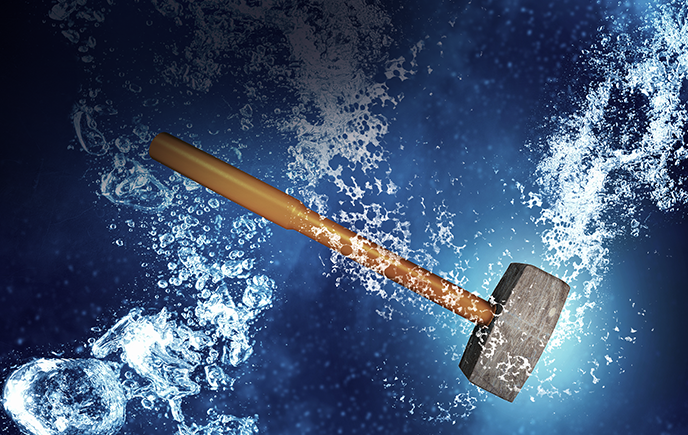Full steam ahead - Scottish distillery with Grundfos
There’s steam and there’s high-quality steam. There are pump solutions and intelligent pump solution...
In commercial and industrial fluid systems. In small dental surgeries and large manufacturing facilities. In mobile water-carrying equipment (like street sweepers). And in industrial processes using pressurised water. In all these places, water hammer hits hard. Think of it as “hydraulic shock” and you can begin to understand how it can cause serious damage, and why you need to deal with it.

The shock is caused by a pressure spike or surge, when fluid in motion through the system is forced to a sudden stop. In process applications, the stop can be caused by a fast-acting valve closing a pipe while fluid upstream is still moving. The water hits the closed valve, bounces back, and creates a wave throughout the upstream system.
Pressure spikes from these waves have been measured at up to 5 times higher than normal water pressure in the pipeline. That’s far above typical UL safety ratings, and enough to cause serious damage to seals, gauges, pipes, hoses and other fittings. If it happens repeatedly, the over-pressurisation and vibration can result in anything from premature wear to catastrophic component failure.
The hammering noise that water hammer creates is hard to ignore. The problems it can cause mean it shouldn’t be.
Engineers have come up with many different solutions to water hammer, but their ideas all crack under pressure.
Fitting a regulator upstream of the valve will lower the surge pressure, but it also reduces the flow rate, which can reduce system performance and productivity. Upstream check valves can reduce the shock’s impact, by stopping the pressure spike from travelling throughout the whole system. A pressurised accumulator can be installed, to divert the excess fluid until the pressure spike abates. Or a shock absorber in the form of a water hammer arrestor can be added to the upstream system.
These will all be more or less effective. But they will also add more cost and more complexity to the system. And more complexity means more points of potential failure.
A more radical solution is to modify the whole system design, adding elbows and loops to the piping to try to slow down the surge velocity. Again, this increases system complexity and potential for failure, and adds to the cost – as well as requiring more space.
IMI Buschjost’s approach is different. It’s the closure of the valve that causes the problem, so they looked at the valve for the solution.
Fluid systems using 2-way valves need the valves to close rapidly, for safe, effective operation. But that’s also the cause of water hammer.
The answer from IMI Buschjost is a choice of 2-way solenoid valves – the Series 82410 and the Series 82740 – that close quickly, but also smoothly and gently. Their proprietary internal design means they can close in a quarter-second, but produce only one-fifth of the pressure surge typical of other similar valves.
Comparative testing against three other best-selling, directly comparable valves highlighted the difference.
When the power was shut-off and the valves moved to their closed position, the upstream pressure was measured every 100 milliseconds. Two of the competitor valves hit pressure peaks of 1440psi, and one reached 1101 psi (approximately 100 bar and 75 bar respectively). Two of the valves also created not one but two pressure spikes, before the pressure finally returned to normal at 87psi.
In contrast, the pressure of the single spike caused by the IMI Buschjost 82410 was more than 80% less, at just 265psi (18 bar).
The valves are available in brass (IMI Buschjost 82410) and 316 stainless steel for more aggressive operating environments (IMI Buschjost 82740). Used in a new system, their compact size gives engineers more design flexibility and more control of their equipment footprint. Used in an existing system as an upgrade, the valves can be a straight swap for those they’re replacing.
Water hammer, hydraulic shock or pressure spike: whatever you want to call it, IMI Buschjost have solved it where it starts. At the valve.
IMI Buschjost products form part of the process control valve offering from IMI Precision Engineering and complement a wide range of pneumatic motion and control technologies within their IMI Norgren product range.
Get the latest updates from ERIKS including:
Choose any or all of these via the ERIKS Subscription Centre!
Our Know+How brings together the best of the latest Know+How Hub articles in one easy to digest magazine, covering the following topics:
That's why its the leading magazine for maintenance engineers from ERIKS.
Want Know+How Magazine delivered direct to your door? Visit the ERIKS Subscription Centre to opt-in!
Take a look at our latest updates...
There’s steam and there’s high-quality steam. There are pump solutions and intelligent pump solution...
Looking for a custom Product quote? Need an answer to a Technical question? Looking for Careers/HR support? Want to work with us? Interested in our Digital Trading solutions? Have a finance question? Send us your enquiry and a member of the ERIKS team will be with you quickly.
We strive to deliver exceptional quality service and products. As part of this goal, we encourage customers to submit feedback on their experiences so we can resolve any issues and concerns.
At ERIKS we strive to deliver the best quality service and products. As part of this goal we encourage customers to submit feedback on their experiences so we can resolve any issues and concerns.
Call us: +441215086000
